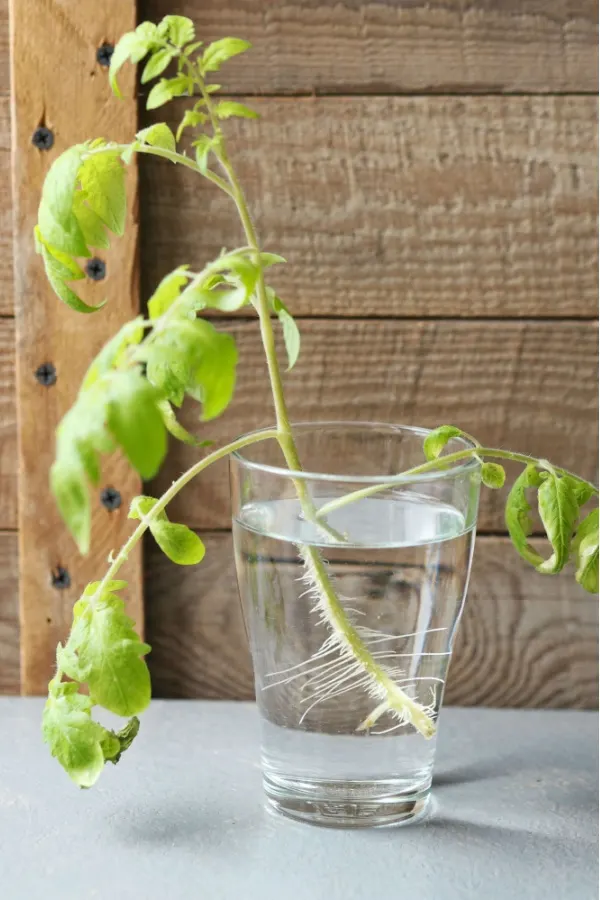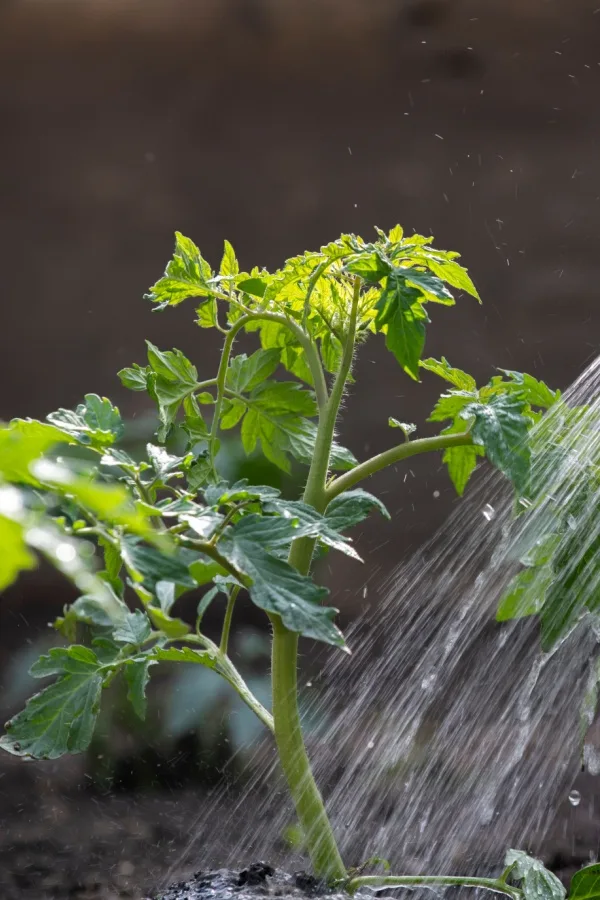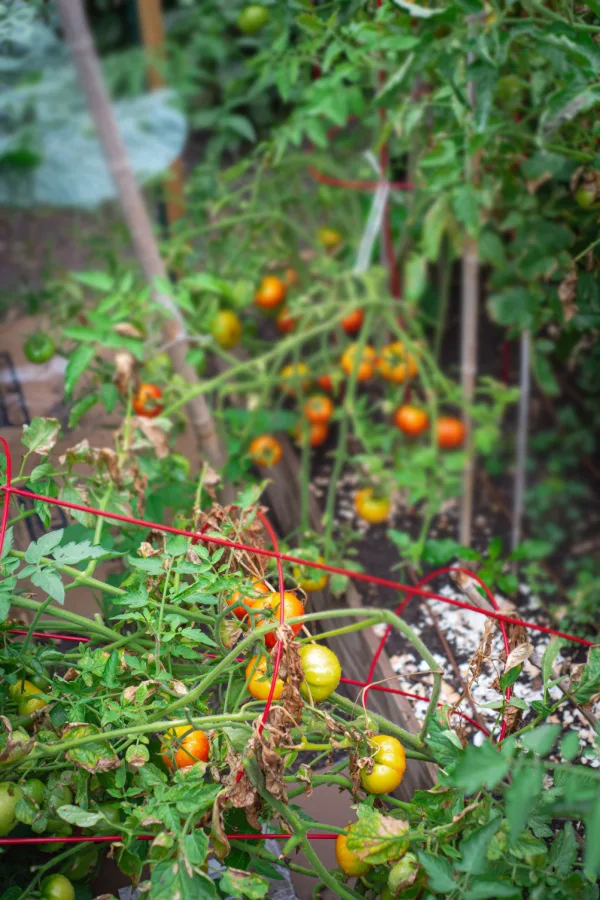When it comes to providing your tomatoes with a strong and healthy foundation, one of the easiest ways to ensure success is to plant your tomatoes deep. Very deep!
This simple springtime planting task can make the difference between a tomato plant that thrives and grows well all season long without worry of having enough water or nutrients – or one that struggles to stand up against all that mother nature throws at it.
In fact, properly planting tomatoes deep enough can be just as important as the type of soil they grow in, the amount of sunlight your plants get, and the water intake they receive throughout the growing season. But how deep is deep enough?

When it comes to many garden crops, you typically want to avoid planting them too deeply in the soil. This can cause the stem of the plants to quickly rot due to excess soil exposure and moisture. However, when it comes to tomatoes, the deeper you can plant them the better.
With tomato growing success in mind, here is a look at exactly why and how to plant your tomato transplants deep in the soil this year – and all the amazing benefits it can provide them!
Why You Need To Plant Tomatoes Deep
Creating More Roots
Unlike most garden crops that only produce roots along the base of the stem, tomatoes have the ability to produce new roots all along the length of the buried stem.
If you look closely at the stem of a tomato plant, you will see little nodes sticking out all along its length. They look like tiny bumps and are often seen along the soil line of mature tomato plants. In some plants, these nodes can create aerial roots. These are roots that do not need soil in order to sprout and grow. This occurs in a lot of vining crops and even some houseplants.

With tomatoes, however, these nodes only mature once they are exposed to soil. When this occurs, they then turn into full-size roots. Roots that can absorb water and energy for the plant. Of course, it goes without saying, the more roots a tomato plant has, the sturdier and healthier it will be throughout the growing season.
Better Protection From Heat And Moisture
If you were to plant your tomatoes with only about one inch of the stem buried, it would take a long time for those tiny few roots to grow down deep into the soil. This result is a very shallow root system that struggles to soak in enough water and nutrients for the plant.
But when you bury 6 to even 10 inches of stem in the ground, those roots are already deep in the ground to begin with. And they can now quickly grow bigger and deeper. Even more, all of those tiny nodes and hairs will continue to grow even more roots underground!
Why is that an advantage? Well, having the roots grow deep in the soil helps to protect them and the overall plant from fluctuations in both temperatures and moisture. Shallow root systems have to rely heavily on surface rainwater and hand watering to provide them with proper moisture.

But roots that grow down deep can typically reach their own moisture far down into the soil. In addition, they are also more insulated from the constantly changing weather conditions above the soil. This is especially important during the hot, dry spells that summer can sometimes bring.
Stronger Root System – Plant Tomatoes Deep
A larger number of roots also means that the tomatoes can absorb way more nutrients and moisture and distribute them throughout the plant. This increase in resources results in healthier, stronger plants that are able to produce and support even more new growth and more blooms.
Instead of only having a few shallow roots taking in these resources right near the plant’s base and quickly depleting them from the soil, the multiple roots of a tomato plant that has been planted deep can grow out in all directions and seek out these resources from much further away.
Along with having additional roots this planting process creates an overall stronger root system. The more roots you have, the sturdier and more grounded the plants will be. Some tomato plant varieities can grow up well over six feet tall. And when they start producing tomatoes, they will become quite heavy.

Even with tomato cages and supports, these massive plants can easily succumb to damage from wind, rain, and just the weight of the fruit alone. But by having deep and extensive roots, the plant has a much better anchoring source in the ground, helping to keep your tomato plants safe!
How Deep To Plant Tomatoes
Now that you know why to plant tomatoes deep, how deeply should you plant them? While it might seem drastic, the best method is to bury up to two-thirds of the plant. And you don’t even need to remove the leaves prior to planting!
Create a planting hole that is at least two-thirds of the height of the plant, plus a few more inches. This creates a space big enough for the addition of natural fertilizers and nutrients. The exact depth will depend on how large your transplant is. A post hole digger is actually great for making quick work of this task. Product Link: AMES Post Hole Digger
However before you place your tomato into the hole, you need to power it first. Into the hole, add in a few cups of compost. Next, add a quarter cup of worm castings and 2 to 3 tablespoons of spent coffee grounds. The compost, worm castings, and coffee grounds all work to act as a slow-release, natural fertilizer.

Lastly, add a tablespoon or two of powdered egg shells. The egg shells help to provide plants with additional calcium, something that helps to prevent blossom end rot. To see other tips on planting tomatoes, check out “How To Avoid The 3 Biggest Tomato Planting Mistakes”.
Planting The Tomato Transplants Deeply
Finally, place your tomato transplant deep into the hole so two-thirds of the stem is buried underground. Backfill with additional soil and then water well. Finish by topping off the soil around your plants with a thick four inch layer of mulch.
You can also plant tomato transplants deeply using a trench method. For this, create a long trench that is at least 5 to 6 inches below the soil line. Amend the soil just like you would above, adding in plenty of additional nutrients and natural slow-release fertilizers.
Lay the tomato plant on its side at a slight angle. You want to ensure that a few inches of the tomato transplant tip are still above the soil and upright. Backfill, water well, and add mulch around the base of each plant. With either method – your plants will grow triple the roots of a conventionally planted tomato transplant!
Here’s to deep planting, strong tomato plants – and a prolific tomato harvest!
I Grow Tomatoes
Follow Our Facebook Page For Even More Great Tomato Growing Tips! I Grow Tomatoes Facebook Page
I Grow Tomatoes is a website created for those who love all things about tomatoes – from planting and growing – to cooking and canning! We publish two articles every week, 52 weeks a year. Sign up today to follow via email! This article may contain affiliate links.
